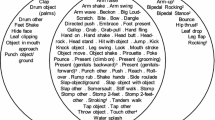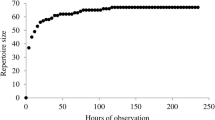Abstract
A growing body of evidence suggests that human language may have emerged primarily in the gestural rather than vocal domain, and that studying gestural communication in great apes is crucial to understanding language evolution. Although manual and bodily gestures are considered distinct at a neural level, there has been very limited consideration of potential differences at a behavioural level. In this study, we conducted naturalistic observations of adult wild East African chimpanzees (Pan troglodytes schweinfurthii) in order to establish a repertoire of gestures, and examine intentionality of gesture production, use and comprehension, comparing across manual and bodily gestures. At the population level, 120 distinct gesture types were identified, consisting of 65 manual gestures and 55 bodily gestures. Both bodily and manual gestures were used intentionally and effectively to attain specific goals, by signallers who were sensitive to recipient attention. However, manual gestures differed from bodily gestures in terms of communicative persistence, indicating a qualitatively different form of behavioural flexibility in achieving goals. Both repertoire size and frequency of manual gesturing were more affiliative than bodily gestures, while bodily gestures were more antagonistic. These results indicate that manual gestures may have played a significant role in the emergence of increased flexibility in great ape communication and social bonding.



Similar content being viewed by others
References
Arbib MA, Liebal K, Pika S (2008) Primate vocalization, gesture, and the evolution of human language. Curr Anthropol 49:1052–1075. doi:10.1086/593015
Arcadi A, Robert D, Boesch C (1998) Buttress drumming by wild chimpanzees: temporal patterning, phrase integration into loud calls, and preliminary evidence for individual distinctiveness. Primates 39:505–518
Arcadi A, Robert D, Mugurusi F (2004) A comparison of buttress drumming by male chimpanzees from two populations. Primates 45:135–139
Bard KA (1992) Intentional behavior and intentional communication in young free-ranging orangutans. Child Dev 63(5):1186–1197
Bruner J (1981) Intention in the structure of action and interaction. In: Lipsett L (ed) Advances in infancy research. Ablex, Norwood
Call J, Tomasello M (1996) The effect of humans on the cognitive development of apes. In: Russon AE, Bard KA, Parker ST (eds) Reaching into thought: the minds of the great apes. Cambridge University Press, New York
Cartmill EA, Byrne RW (2010) Semantics of primate gestures: intentional meanings of orangutan gestures. Anim Cogn 13:793–804
Corballis MC (2003) From mouth to hand: gesture, speech, and the evolution of right-handedness. Behav Brain Sci 26:199–208
Corballis M (2009) Language as gesture. Hum Mov Sci 28:556–565
Crockford C, Wittig RM, Mundry R, Zuberbuehler K (2012) Wild chimpanzees inform ignorant group members of danger. Curr Biol 22:142–146
Crockford C, Wittig R, Langergraber K, Ziegler T, Zuberbueler K, Deschner T (2013) Urinary oxytocin and social bonding in related and unrelated wild chimpanzees. Proc Royal Soc B Biol Sci 280 (1755)
Donald M (1991) Origins of the modern mind: three stages in the evolution of culture and cognition. Harvard University Press, Cambridge
Dunbar RIM (1996) Grooming, gossip and the evolution of language. Harvard University Press, Cambridge
Forrester SG (2008) A multidimensional approach to investigations of behaviour: revealing structure in animal communication signals. Anim Behav 76(5):1749–1760
Genty E, Breuer T, Hobaiter C, Byrne RW (2009) Gestural communication of the gorilla (Gorilla gorilla): repertoire, intentionality and possible origins. Anim Cogn 12:527–546. doi:10.1007/s10071-009-0213-4
Golinkoff RM (1986) I beg your pardon—the preverbal negotiation of failed messages. J Child Lang 13(3):455–476
Goodall J (1986) The chimpanzees of gombe: patterns of behaviour. Harvard University Press, Cambridge
Hewes GW (1973) Primate communication and the gestural origin of language. Curr Anthropol 14:5–24
Hinde RA, Rowell TE (1962) Communication by posture and facial expression in the rhesus monkey. Proc Zool Soc Lond 138:1–21
Hobaiter K, Byrne R (2011a) The gestural repertoire of the wild chimpanzee. Anim Cogn 14:745–767. doi:10.1007/s10071-011-0409-2
Hobaiter K, Byrne R (2011b) Serial gesturing by wild chimpanzees: its nature and function for communication. Anim Cogn 14:827–838. doi:10.1007/s10071-011-0416-3
Hopkins WD, Pika S, Liebal K, Bania A, Meguerditchian A, Gardner M, Schapiro SJ (2012) Handedness for manual gestures in great apes. In: Developments in Primate Gesture Research, vol 6, pp 93–111
Krause MA, Fouts RS (1997) Chimpanzee (Pan troglodytes) pointing: hand shapes, accuracy, and the role of eye gaze. Int J Comp Psychol 11:330–336
Leavens DA, Hopkins WD (1998) Intentional communication by chimpanzees: a cross-sectional study of the use of referential gestures. Dev Psychol 34:813–822
Leavens DA, Hopkins WD, Bard KA (1996a) Indexical and referential pointing in chimpanzees (Pan troglodytes). J Comp Psychol 110(4):346–353
Leavens DA, Hopkins WD, Bard KA (1996b) Indexical and referential pointing in chimpanzees (Pan troglodytes). J Comp Psychol 110:346–353
Leavens DA, Hostetter AB, Wesley MJ, Hopkins WD (2004) Tactical use of unimodal and bimodal communication by chimpanzees, Pan troglodytes. Anim Behav 67:467–476. doi:10.1016/j.anbehav.2003.04.007
Leavens DA, Russell JL, Hopkins WD (2005) Intentionality as measured in the persistence and elaboration of communication by chimpanzees (Pan troglodytes). Child Dev 76:291–306
Liebal K, Call J (2012) The origins of non-human primates’ manual gestures. Philos T R Soc B 367:118–128
Liebal K, Call J, Tomasello M (2004) Use of gesture sequences in chimpanzees. Am J Primatol 64:377–396
McCarthy MS, Jensvold MLA, Fouts DH (2012) Use of gesture sequences in captive chimpanzee (Pan troglodytes) play. Anim Cogn:1–11
Meguerditchian A, Vauclair J, Hopkins WD (2010) Captive chimpanzees use their right hand to communicate with each other: implications for the origin of the cerebral substrate for language. Cortex 46:40–48
Mundry R, Fischer J (1998) Use of statistical programs for nonparametric tests of small samples often leads to incorrect P values: examples from animal behaviour. Anim Behav 56:256–259
Nishida T, Koichiro Z, Takahisa M, Agumi I, McGrew WC (2010) Chimpanzee behavior in the wild: an audio-visual encyclopaedia. Springer, Tokyo
Parkinson B (1996) Emotions are social. Brit J Psychol 87:663–683
Parr LA, Cohen M, Waal FD (2005) Influence of social context on the use of blended and graded facial displays in chimpanzees. Int J Primatol 26:73–103
Pika S, Mitani J (2006) Referential gestural communication in wild chimpanzees (Pan troglodytes). Curr Biol 16:R191–R192
Pika S, Liebal K, Tomasello M (2005) Gestural communication in subadult bonobos (Pan paniscus): repertoire and use. Am J Primatol 65(1):39–61
Plooij FX (1978) Some basic traits of language in wild chimpanzees. In: Lock A (ed) Action, gesture and symbol: the emergence of language. Academic press, London, pp 111–131
Plooij FX (1979) How wild chimpanzee babies trigger the onset of mother-infant play–and what the mother makes of it. In: Bullowa M (ed) Before speech: the beginning of interpersonal communication. Cambridge University Press, New York, pp 223–243
Plooij F (1984) Behavioural development of free-living chimpanzee babies and Infants. Ablex Publishing Corporation, Norwood
Pollick AS, de Waal FBM (2007) Ape gestures and language evolution. P Natl Acad Sci USA 104:8184–8189
Puce A, Perrett D (2003) Electrophysiology and brain imaging of biological motion. Philos T R Soc B 358:435–445
Reynolds V (2005) The chimpanzees of the Budongo forest: ecology, behaviour, and conservation. Oxford University Press, Oxford
Rizzolatti G, Arbib MA (1998) Language within our grasp. Trends Neurosci 21:188–194
Roberts AI, Vick S-J, Buchanan-Smith H (2012a) Usage and comprehension of manual gestures in wild chimpanzees. Anim Behav 84:459–470. doi:10.1016/j.anbehav.2012.05.022
Roberts AI, Vick S-J, Roberts SGB, Buchanan-Smith HM, Zuberbühler K (2012b) A structure-based repertoire of manual gestures in wild chimpanzees: statistical analyses of a graded communication system. Evol Hum Behav 33(5):578–589. doi:10.1016/j.evolhumbehav.2012.05.006
Roberts AI, Vick S-J, Buchanan-Smith H (2013) Communicative intentions in wild chimpanzees: persistence and elaboration in gestural signalling. Anim Cogn 16(2):187–196. doi:10.1007/s10071-012-0563-1
Scott N (2013) Gesture use by chimpanzees (Pan troglodytes): differences between sexes in inter- and intra-sexual interactions. Am J Primatol 75:555–567
Seyfarth R, Cheney DL, Marler P (1980) Vervet monkey alarm calls: semantic communication in a free-ranging primate. Anim Behav 28:1070–1109
Seyfarth RM, Cheney DL, Bergman T, Fischer J, Zuberbuhler K, Hammerschmidt K (2010) The central importance of information in studies of animal communication. Anim Behav 80:3–8. doi:10.1016/j.anbehav.2010.04.012
Slocombe KE, Waller BM, Liebal K (2011) The language void: the need for multimodality in primate communication research. Anim Behav 81:919–924. doi:10.1016/j.anbehav.2011.02.002
Smith LW, Delgado R (2013) Considering the role of social dynamics and positional behaviour in gestural communication research. Am J Primatol
Tomasello M, Call J (1997) Primate cognition. Oxford University Press, New York
Tomasello M, Carpenter M (2007) Shared intentionality. Dev Sci 10(1):121–125. doi:10.1111/j.1467-7687.2007.00573.x
Tomasello M, Frost GT (1989) A longitudinal investigation of gestural communication in young chimpanzees. Primates 30(1):35–50
Tomasello M, Zuberbühler K (2002) Primate vocal and gestural communication. In: Bekoff M, Allen CS, Burghardt G (eds) The cognitive animal: empirical and theoretical perspectives on animal cognition. MIT Press, Cambridge
Tomasello M, Call J, Nagell K, Olguin R, Carpenter M (1984) The learning and use of gestural signals by young chimpanzees: a trans-generational study. Primates 37:137–154
Tomasello M, George BL, Kruger AC, Jeffrey M, Evans FA (1985) The development of gestural communication in young chimpanzees. J Hum Evol 14:175–186
Tomasello M, Call J, Nagell K, Olguin R, Carpenter M (1994) The learning and use of gestural signals by young chimpanzees: a trans-generational study. Primates 35(2):137–154
Tomasello M, Call J, Warren J, Frost T, Carpenter M, Nagell K (1997) The ontogeny of chimpanzee gestural signals: a comparison across groups and generations. Evol Com 1(2):223–253
van Hooff JARAM (1971) Aspects of the social behaviour and communication in human and higher non-human primates. Bronder-Offset, Rotterdam
van Lawick-Goodall J (1967) Mother-offspring relationships in free-ranging chimpanzees. In: Morris D (ed) Primate ethology. Weidenfeld and Nicolson, London, pp 287–346
van Lawick-Goodall J (1968) A preliminary report on expressive movements and communication in the gombe stream chimpanzees. In: Jay P (ed) Primates: studies in adaptation and variability. Holt, Reinhart and Winston, New York, pp 313–374
Wallez C, Schaeffer J, Meguerditchian A, Vauclair J, Schapiro SJ, Hopkins WD (2012) Contrast of hemispheric lateralization for oro-facial movements between learned attention-getting sounds and species-typical vocalizations in chimpanzees: extension in a second colony. Brain Lang 123:75–79
Warneken F, Chen F, Tomasello M (2006) Cooperative activities in young children and chimpanzees. Child Dev 77(3):640–663
Whiten A, Goodall J, McGrew WC, Nishida T, Reynolds V, Sugiyama Y, Tutin CEG, Wrangham RW, Boesch C (1999) Cultures in chimpanzees. Nature 399:682–685
Acknowledgments
The fieldwork for this research has been funded by an Economic and Social Research Council + 3 studentship and by the University of Stirling to A.R. We thank Professor Klaus Zuberbühler, the National Council for Science and Technology and Uganda Wildlife Authority in Uganda for granting permission for this work, and the Royal Zoological Society of Scotland for providing core funding for the Budongo Conservation Field Station. We thank the staff at Budongo Conservation Field Station, Uganda, especially Geresomu Muhumuza and Amati Steven for providing excellent support in the field.
Author information
Authors and Affiliations
Corresponding author
Electronic supplementary material
Below is the link to the electronic supplementary material.
Rights and permissions
About this article
Cite this article
Roberts, A.I., Roberts, S.G.B. & Vick, SJ. The repertoire and intentionality of gestural communication in wild chimpanzees. Anim Cogn 17, 317–336 (2014). https://doi.org/10.1007/s10071-013-0664-5
Received:
Revised:
Accepted:
Published:
Issue Date:
DOI: https://doi.org/10.1007/s10071-013-0664-5




